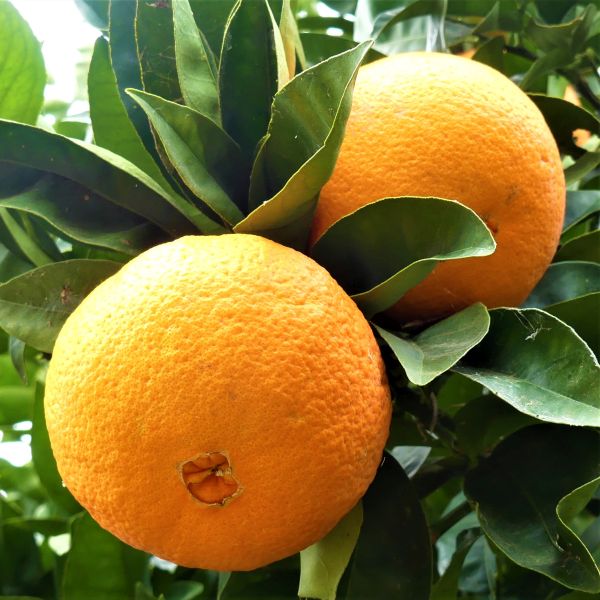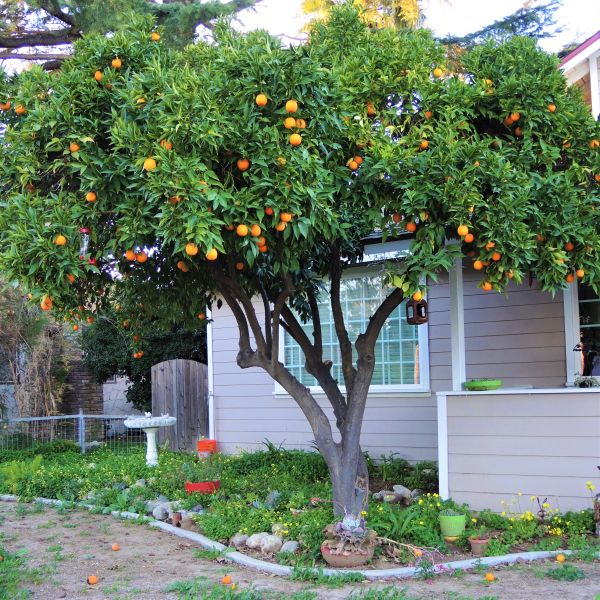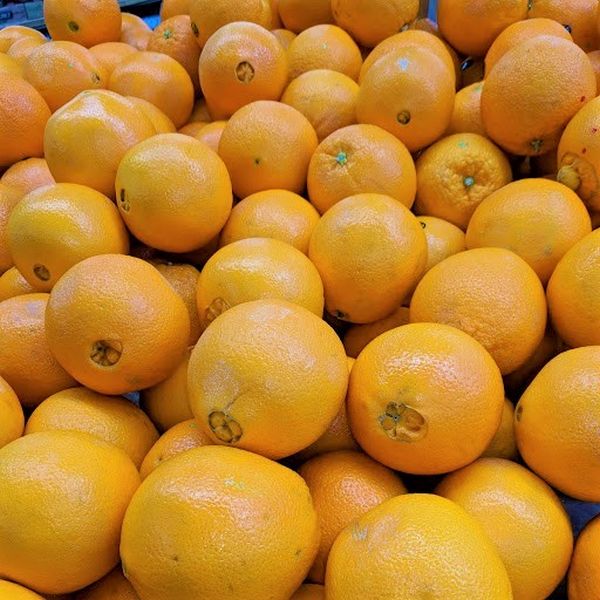Washington Navel Orange Tree
Citrus sinensis 'Washington'
Plant Sentry™
Plant Sentry™

Plant Sentry™ Protected
Your order is protected by our compliance system that:
- Prevents restricted plants from shipping to your state
- Ensures plants meet your state's agricultural requirements
- Protects gardens from invasive pests and diseases
Delivery and Shipping
Delivery and Shipping
Delivery and Shipping
Fast, Safe Plant Delivery
Ships in 3-4 business days • Tracking provided • Weather protected
| Under $50 | $9.99 |
| $50 - $99.99 | $14.99 |
| $100 - $149.99 | $16.99 |
| $150 - $198.99 | $24.99 |
| $199+ | FREE |
✓ Zone-specific timing • ✓ Professional packaging • ✓ Health guarantee
Understanding Plant Options
Nature Hills offers plants in two main formats:
- Container Plants: Grown in pots with soil, sized by container volume and plant age
- Bare Root Plants: Dormant plants without soil, sized by height measurements
Container Plant Sizes
Container sizes indicate plant age and growing capacity rather than liquid volume equivalents. Our containers follow industry-standard nursery "trade gallon" specifications, which differ from standard liquid gallon measurements.
Young Plants (6 months to 18 months old)
| Container Size | Actual Volume | Metric Equivalent |
|---|---|---|
| 2" x 2" x 3" | 0.18 - 0.21 dry quarts | 0.20 - 0.23 dry liters |
| 4" Container | 0.31 - 0.87 dry quarts | 0.35 - 0.96 dry liters |
| 4.5" Container | 0.65 dry quarts | 0.72 dry liters |
| 6" Container | 1.4 dry quarts | 1.59 dry liters |
| 1 Quart | 1 dry quart | 1.1 dry liters |
| 5.5" Container | 1.89 dry quarts | 2.08 dry liters |
Established Plants (18 months to 2.5 years old)
| Container Size | Actual Volume | Metric Equivalent |
|---|---|---|
| 2 Quart | 2 dry quarts | 2.2 dry liters |
| #1 Container | 2.26 - 3.73 dry quarts | 2.49 - 4.11 dry liters |
| 5" x 5" x 12" | 3.5 - 4.3 dry quarts | 3.85 - 4.74 dry liters |
Mature Plants (2-4 years old)
| Container Size | Actual Volume | Metric Equivalent |
|---|---|---|
| #2 Container | 1.19 - 1.76 dry gallons | 5.24 - 7.75 dry liters |
| #3 Container | 2.15 - 2.76 dry gallons | 8.14 - 12.16 dry liters |
Large Plants (3-5 years old)
| Container Size | Actual Volume | Metric Equivalent |
|---|---|---|
| #5 Container | 2.92 - 4.62 dry gallons | 12.86 - 20.35 dry liters |
| #6 Container | 5.25 - 6.01 dry gallons | 23.12 - 26.42 dry liters |
| #7 Container | 5.98 - 6.53 dry gallons | 26.34 - 28.76 dry liters |
Bare Root Plants
Bare root plants are sold by height from the root system to the top of the plant. Plants may exceed minimum height requirements.
Common Sizes:
- Trees: 1 foot, 2 feet, 3 feet, 4 feet, 5 feet, 6 feet
- Shrubs & Perennials: 1 foot, 18 inches, 2 feet
Important Notes
Container Volume Specifications
- Trade Gallon Standard: Our containers follow industry-standard "trade gallon" specifications established by the American National Standards Institute (ANSI Z60.1) for nursery stock
- Volume Variations: Actual soil volume may vary due to plant root systems and growing medium settlement
- Age Indicators: Container size primarily indicates plant age and maturity rather than liquid volume equivalents
Growing Conditions
- Plant size can vary based on variety and growing conditions
- Container size helps indicate plant maturity and establishment level
- Larger containers generally mean more established root systems and faster landscape establishment
Seasonal Availability
- Bare root plants are available seasonally when dormant
- Container plants are available throughout the growing season
- Specific varieties may have limited availability in certain sizes
Questions?
For questions about specific plant sizes or availability, please contact our plant experts who can help you choose the right size for your landscape needs.

Plant Sentry™ Protected
Your order is protected by our compliance system that:
- Prevents restricted plants from shipping to your state
- Ensures plants meet your state's agricultural requirements
- Protects gardens from invasive pests and diseases
Plant Profile & Growing Essentials
Evergreen, Flowering, Self-pollinating, Edible, Fragrant, Heat Tolerant, and Container Friendly
Specifications
Specifications
-
Botanical Name
-
Height
-
Width
-
Growing Zones
-
Sunlight
-
Growth RateModerate
-
Flower Color
-
Leaf Color
-
Fall Color
-
Pollinator FriendlyYes
-
Pollinator Required
-
Bloom PeriodEarly Spring, Late Spring, Early Summer, Late Summer
-
FragrantYes
Planting & Care Instructions
Planting & Care Instructions

Growing Zones 9-10 (patio 4-10)
The Most Popular Washington Navel Orange Tree! People think of Washington Navel Oranges when they think of an Orange. The delicious fruit is seedless and easy to peel.
There are a lot of things to love about this fruit-bearing tree. No wonder it's the most popular orange grown in the world. The fruit is sweet and has just enough juice for outstanding fresh eating.
It won't make you wait long for your first crop, because it matures early. It's also one of the first fruits ready for the winter harvest. Only a few varieties of orange like the wonderful pink-fleshed Cara Cara ripen earlier.
It's a high-yield variety, so you'll enjoy plenty of the rich-tasting, easy-peeling oranges. These are large, meaty pieces of fruit that are easy to peel and separate.
No wonder they are a traditional part of all school lunches around the country! They are sweet enough for kids to love, too.
Your bounty can be left on the tree for up to three months without sacrificing its quality or integrity. This makes it easy to harvest as many as you want throughout the season, which is perfect for the small-time or backyard grower.
Imagine growing your own fresh oranges and having the luxury of harvesting them at your leisure all through the winter months! What a healthy addition to your daily life.
Order today and start eating 'really local'!
Not Just Fruit! It's A Useful Ornamental Tree, As Well
The Washington Navel Orange Tree (Citrus sinensis 'Washington') is not all about function. Its form is definitely pleasant too, providing your yard with aesthetic beauty in any location you choose to plant it.
As you can imagine, the beautiful, waxy, white flowers smell absolutely incredible. They'll perfume your whole yard with that to-die-for, fresh citrus scent, adding to your outdoor enjoyment from spring and well into summer.
Local songbirds will love to nest in the tree. Keep your eyes out for Hummingbirds, they'll love those fragrant blooms!
One of the best-kept secrets about growing fruit trees is that you can keep them easily pruned to the height and width you desire. Need a tiny tree? Do summer pruning for size control.
If you let it grow into a medium-sized tree, the Washington Navel Orange is an ideal single-trunk tree. You can consider this a very giving specimen tree with a majestic look.
Or, keep the lower branches on to use it as a cute, rounded bush. These can be planted six to eight feet apart - measuring from the center of one to the center of the next - and become a useful privacy screen or hedge to block out an unwanted view.
Although it can grow to a substantial size in the ground, the Washington Navel Orange is also suitable for container growing and can be pruned to any desired size and shape.
Yes, you can even grow it in a container. Now we have the cold winter gardeners smiling!
Citrus, in general, are well suited for container growing and in areas where space is limited or a move to a new home may be in your future, grow your Washington Navel Orange in a container.
You can keep container plants limbed up as a small tree or kept bushier as a shrub. Either way, the Washington Navel is a fabulous addition to your edible landscaping.
- Delicious, Seedless Fruit - Great for Fresh Eating
- White Blossoms With Incredible Fragrance
- Produces Fruit Early & No Pollinator Required
- High Productivity & Conveniently Long Hang Time on Tree
- Most Popular Backyard Orange in the United States & Worldwide
- Beautiful Edible & Ornamental
#ProPlantTips for Care
Washington Navel Trees prefer full sun and fertile, well-drained soil conditions. It requires a moderate amount of watering.
If you'll be growing it in the ground, please ensure it has good drainage. If you see puddles long after a rain, you'll want to build a raised bed 12 to 18 inches high and 3 feet square.
In colder climates, the Washington Navel tree growing in a container must be moved indoors for winter. Give it the brightest light you can and maintain moderate humidity to produce fruit successfully. Keep it in a greenhouse or attached sunroom is best.
A single tree will produce fruit, but we recommend planting at least two for the largest fruit set.
Protecting Container Citrus From Cold
If you're growing these tropical trees in the ground in the lowest of their favored growing zones, they need to be planted in a sheltered spot to avoid the worst of the chill. If a spot like that is unavailable then you are better off planting in a large, deep container.
This Citrus variety naturally grows successfully in marginal Citrus areas (USDA zones 8 to 4). But Citrus trees grown in these zones should be grown in containers and brought indoors before the wintertime.
In cooler growing zones, begin slowly acclimating your tree indoors in the early fall or moving them into a protected location, eventually moving your tree inside in bright indirect sun for the winter if the temperatures in your area ever dip below that 40°F range.
In spring, reverse this process and begin acclimating your tree to again be back out in the full sun all summer. This reduces stress and leaf drop.
Our trees are always in high demand, and we expect these citrus trees to be very popular. Order now before they sell out and enjoy the benefits of growing your own easy-peeling fruit anywhere in the United States!
The History of America’s #1 Orange
The Washington Navel Orange had a long journey to become America's #1 orange. It was well worth the wait!
By the early 1800s, missionaries had planted citrus orchards in Brazil, Central America, Florida, and Mexico. In the early 1840s, William Wolfskill planted what is considered the first commercial citrus orchard in Southern California. Wolfskill grew mostly lemons and oranges from seed, but he is credited with establishing the market for citrus growing in California.
Many growers of the period worked to create a superior quality sweet orange, but very few succeeded. In 1877, Thomas Garey introduced a seedling called 'Garey's Mediterranean Sweet' which was immediately recognized for its fruit quality. Shortly afterward, Garvey began getting requests for this plant from all over the world. However, after the introduction of the Washington Navel, the popularity of Garey's variety would fall sharply.
During the same time period, news emerged of a far superior sweet orange variety. Since 1820, budwood from a tree discovered in a monastery in Brazil was being sent to Citrus-growing regions. However, these first trees proved to have inferior quality.
In the late 1860s, William Saunders with the US Department of Agriculture in Washington, D.C., learned of this superior sweet orange from a neighbor who has just returned from Brazil. Saunders contacted a missionary there and was shipped budded trees in 1870. This is the credited time of introduction for the Washington Navel (although it hadn't been named at that time!)
Saunders propagated this new variety and sent trees to Florida and 3 locations in California. The variety did not do well in Florida, but the California trees did well. Two of the budded trees were sent to Saunders former neighbor Eliza and Luther Tibbetts. The Tibbetts had just moved to Riverside in Southern California and purchased 8 acres of land. The trees grew well by the side of their house.
By the early 1880s, the" Riverside Navel" had caught on quite well with local growers and nurseries throughout California and was gaining popularity throughout the United States. To keep with the national appeal, the decision was made to change the name to the George Washington Navel. This in time was shortened to Washington Navel.
Because of the Washington Navel's seedless nature, planting seeds wasn't possible. With no seed available, all propagation was done by budding or grafting to seedling rootstocks. This means that nearly all the Washington Navels grown in California to date originate from Eliza Tibbetts original two trees. They were moved from their original location. One of the trees died, but the other tree is still alive and a registered historical monument in Riverside, California, still setting fruit at over 145 years old. What a legacy!














